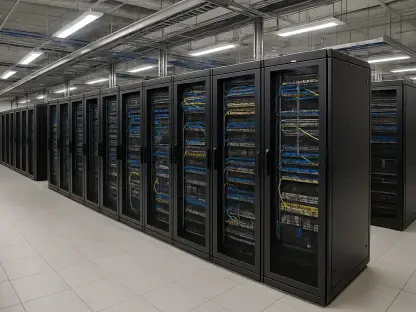Over the past decade, the landscape of home networking has undergone a remarkable transformation. The advancement in wireless technology, coupled with increasing demands for robust internet solutions, has led to the rise of mesh Wi-Fi systems, which have overshadowed traditional standalone routers. This trend reflects the growing needs of contemporary households filled with smart devices, creating a necessity for consistent and widespread Wi-Fi coverage. The shift toward mesh technology is not just a technological upgrade; it symbolizes a change in consumer expectations and usage patterns. This evolution is driven by the desire for seamless connectivity across large and architecturally complex homes, making standalone routers seem inadequate in comparison.
Introduction to Mesh Wi-Fi Systems
Mesh Wi-Fi technology has redefined internet connectivity in modern homes by offering a more comprehensive and reliable solution than traditional routers. Unlike traditional routers, which rely on a single access point to distribute the internet signal, mesh systems use multiple nodes strategically placed around the home to deliver uniform coverage and eliminate dead spots. This network configuration ensures that signals can reach every corner of the house, maintaining consistent internet speed and connectivity regardless of where a device is located. The emergence of mesh Wi-Fi in the mid-2010s marked a significant shift in consumer home networking, with brands like Eero and Google Nest making these systems more accessible to the average user.
The appeal of mesh Wi-Fi systems lies in their capability to cover large and multi-level homes without requiring additional extenders or cumbersome cabling. This ease of deployment and the powerful coverage of mesh networks have proven to be game changers for families with large properties or homes with layouts that hinder traditional signal reach. Furthermore, mesh Wi-Fi setups are synonymous with simplicity in management, often supported by user-friendly mobile apps that allow easy monitoring and control of the network. As a result, even those without a technical background can configure and manage their home network effectively, which has significantly contributed to the widespread adoption of mesh systems over standalone routers.
Common Themes and Key Points
Mesh Wi-Fi systems address various challenges presented by conventional routers, particularly in the areas of coverage, reliability, and ease of use. Modern households equipped with numerous smart lightbulbs, security cameras, and home assistants necessitate dependable Wi-Fi coverage to ensure these devices operate efficiently. Mesh networks offer a solution by blanketing the entire home in a seamless wireless signal, thus supporting uninterrupted functionality of all connected devices. This comprehensive coverage feature eliminates the need for additional signal boosters, making mesh systems an attractive choice for those seeking efficiency without the clutter of multiple gadgets.
Reliability and scalability are other critical attributes that set mesh Wi-Fi systems apart from traditional routers. The distributed nature of mesh networks reduces the risk of bottlenecking or signal congestion, providing a more stable internet connection even in environments densely packed with digital devices. This reliability is particularly crucial for smart home ecosystems, where devices constantly communicate with each other and the cloud. Moreover, the modular design of mesh systems allows users to easily expand their network by adding more nodes, thereby increasing coverage in response to changes in home size or layout. This flexibility stands in contrast to the limitations of standalone routers, which can struggle to meet the evolving needs of a dynamic household environment.
Overarching Trends and Consensus Viewpoints
The shift toward mesh Wi-Fi is driven by an increasing dependence on smart technology, which requires robust and reliable internet infrastructure. As smart home devices become more integrated into daily life, the need for seamless connectivity has transformed from a luxury into a necessity. Homes with multiple levels, thick walls, or vast square footage often demand a network solution that can penetrate these barriers, ensuring that every smart device from the basement to the attic remains connected. This ongoing reliance on smart technology suggests that mesh systems are well-positioned to become a standardized fixture in home networking solutions, potentially phasing out standalone routers in expansive settings.
This transition reflects a broader trend in consumer technology where more emphasis is placed on convenience and user experience. Mesh networks highlight the importance of stable and accessible internet as underpinning smart home technologies, thus catering to a growing expectation for devices that integrate smoothly into daily routines. As these systems evolve, they are expected to push the boundaries of what is achievable in home networking, combining advancements in internet technology with user-centric innovations that simplify installation and management. Consequently, the expectation is that mesh systems will continue to dominate the market, advancing beyond the typical confines of residential spaces and into commercial zones, further challenging the role of standalone routers.
Comparative Analysis of Standalone Routers vs. Mesh Systems
While mesh Wi-Fi systems are lauded for their superior coverage and reliability, standalone routers still find their place in smaller, less demanding settings. Traditional routers are often favored in compact environments, such as apartments or small homes, where a single-point network can suffice. These routers can provide excellent performance and speed, particularly those compatible with the latest Wi-Fi 6E standards, which offer advanced capabilities and support for a larger number of connected devices. In terms of raw data throughput, standalone routers may excel, particularly when proximity to the router is maintained, thereby supporting demanding tasks like high-definition streaming or online gaming.
Mesh systems, in comparison, cater predominantly to larger homes or those with complex architectural elements that obstruct signal penetration. Their strategic distribution of nodes not only extends coverage but also enhances signal consistency, an advantage in environments where typical router capacity falls short. However, this advantage comes with a higher price tag, as mesh systems tend to be more expensive, sometimes rivaling the cost of multiple high-performance standalone routers. The increased financial investment and potential for increased setup complexity pose challenges, especially for consumers who may not require such extensive coverage. Despite these considerations, for households seeking the ultimate solution in Wi-Fi coverage and reliability, mesh systems continue to be the preferred choice.
Drawbacks of Mesh Wi-Fi Systems
While mesh Wi-Fi offers undeniable advantages in many regards, it also presents challenges that can deter potential users. The foremost concern for consumers when considering mesh systems is cost. High-end mesh networks can be substantial investments, with premium models reaching up into the thousands of dollars, reflecting their capacity and technological sophistication. This price point can often seem prohibitive, particularly when contrasted with the more budget-friendly options offered by conventional routers, which can adequately serve the needs of smaller and less device-heavy households.
Another difficulty associated with mesh Wi-Fi is the complexity sometimes entailed in their setup and management. Although designed to be user-friendly, the configuration process can nevertheless be daunting for some, especially when integrating a multitude of nodes that must work in harmony. These challenges can be exacerbated by compatibility issues with specific smart devices, especially those only supporting older Wi-Fi bands such as the 2.4GHz spectrum, which sometimes struggle to communicate effectively within a contemporary mesh setup. Addressing these issues requires either technical savvy or assistance from customer support, which can negate some of the expected benefits in ease of use.
Synthesis of Consumer Experiences and Technological Insights
Overall, consumer feedback on mesh Wi-Fi systems generally highlights satisfaction with the reliable and extensive coverage these systems provide. For households plagued by spotty connections using traditional routers, mesh networks present a transformative upgrade. Users often report a notable improvement in connectivity, particularly in terms of smart home integration, where devices such as cameras, doorbells, and thermostats demand a stable connection to function optimally. However, this enthusiasm is tempered by considerations of cost and the perceived complexity of setup, which continue to be significant factors deterring some from transitioning away from standalone routers.
Technologically, mesh Wi-Fi represents a burgeoning area of innovation underpinned by advancements in wireless standards such as Wi-Fi 6E and the evolving Wi-Fi 7. These updates not only promise increased speed and efficiency but also anticipate expanding the capacity to support numerous devices without degradation in performance, an essential feature as the Internet of Things grows ever more intricate. Improvements in mesh technology are expected to mitigate current drawbacks, with future iterations potentially simplifying setup processes and achieving greater hybrid functionality with standalone routers, bridging gaps in user experience and affordability.
Projection of Wi-Fi Technology in the Future
Looking ahead, the field of Wi-Fi technology is poised for further breakthroughs that will likely solidify mesh systems as a foundational element in home networking. Innovations such as Wi-Fi 7 and discussions of upcoming Wi-Fi 8 (Ultra High Reliability) showcase an industry moving towards higher standards of connectivity that prioritize reliability and widespread access. As these technologies mature and become mainstream, the expectation is that mesh systems will converge with the features traditionally associated with standalone routers, offering both expansive coverage and the cutting-edge speed capabilities associated with newer wireless standards.
Such advancements promise to resolve existing challenges, potentially decreasing the complexity and cost associated with mesh networks, making them more accessible to a broader range of consumers. Moreover, as society becomes increasingly digital and reliant on interconnected devices, the demand for high-quality Wi-Fi solutions will only intensify, compelling ongoing evolution in networking technology. This momentum suggests a future where mesh systems become the norm, as they seamlessly integrate evolving technological trends and consumer needs, ultimately enhancing how connectivity is experienced in homes and beyond.
Integral Role of Mesh Wi-Fi in Future Home Networking
Over the last ten years, the realm of home networking has seen a dramatic shift. With advancements in wireless technology and the increasing demand for reliable internet connectivity, mesh Wi-Fi systems have emerged as superior to traditional standalone routers. This trend highlights the evolving needs of modern households packed with smart devices, driving the necessity for stable and expansive Wi-Fi coverage. It’s not just a tech enhancement; it’s emblematic of changing consumer expectations and behavior. The evolution is propelled by the desire for uninterrupted connectivity throughout vast and intricately designed homes, placing standalone routers in a position of inadequacy.
Mesh Wi-Fi systems offer a solution to challenges faced by households needing consistent internet coverage in every corner. These systems use multiple nodes to create a seamless network, ensuring connectivity remains robust even as one moves through different parts of a home. This development caters to modern living, where smart televisions, thermostats, security cameras, and more demand reliable and fast internet access. The shift signifies a growing awareness of the importance of connectivity in everyday life and reflects the technology’s ability to meet these rising expectations efficiently. As home networking evolves, mesh Wi-Fi systems are paving the way for a future where connectivity is synonymous with convenience and reliability.









